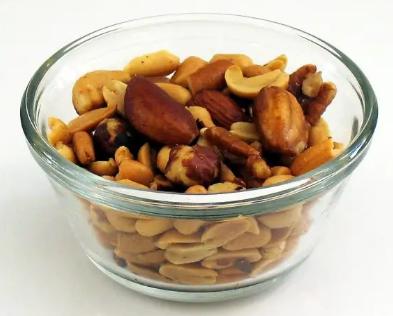博文
巴西坚果效应撼动了物理学
||
巴西坚果效应撼动了物理学
诸平




In a bag of mixed nuts, after shaking, smaller nuts fill in the gaps created at the bottom, pushing the larger Brazil nuts to the top. Credit: Melchoir, CC BY-SA 3.0, via Wikimedia Commons
据波兰华沙大学(University of Warsaw)2023年4月23日提供的消息,关于科学的坚果:巴西坚果效应撼动了物理学(Nuts About Science: The Brazil Nut Effect Shakes Up Physics)。
荷兰乌得勒支大学(Utrecht University, Utrecht, The Netherlands)和波兰华沙大学物理学院(Faculty of Physics, University of Warsaw, Warsaw, Poland)的物理学家,首次通过实验观察到了带电胶体粒子混合物中的巴西坚果效应(Brazil nut effect)。直到现在,人们还认为需要大量的外部能量才能产生这种效果——但研究人员能够确认该过程可以自发发生。该研究结果于2023年2月24日已经在《美国国家科学院院刊》 (The Proceedings of the National Academy of Sciences简称PNAS) 网站发表——Marjolein N. van der Linden, Jeffrey C. Everts, René van Roij, Alfons van Blaaderen. Realization of the Brazil-nut effect in charged colloids without external driving. PNAS, February 24, 2023. 120 (9): e2213044120. DOI: 10.1073/pnas.2213044120. https://www.pnas.org/doi/10.1073/pnas.2213044120
参与此项研究的有来自荷兰乌得勒支的德拜纳米材料科学研究所(Debye Institute for Nanomaterials Science, Utrecht, The Netherlands)、荷兰乌得勒支大学、波兰华沙大学以及波兰科学院(Polish Academy of Sciences, Warsaw, Poland)的研究人员。他们的发现可以在从地质学到软物质物理学的广泛领域中找到应用。
当您打开一罐混合坚果时,通常会摇一摇。您是否注意到,经过这样的操作后,混合物中最大的坚果——巴西坚果——浮到了顶部?大物体上升到小物体混合物表面的现象,专业名称为颗粒对流(granular convection),通常被称为“巴西坚果效应”( “the Brazil nut effect”),在自然界中很常见。也可以通过摇动来观察,例如,一桶沙子和鹅卵石。
这种不寻常的效果与较重的物体由于重力和惯性力应该沉入底部的直觉相矛盾。自然界中常见的沉降现象就是这种情况,该过程涉及分散在液体中的固体颗粒在重力或惯性力的影响下下沉。沉淀作用在沉积岩形成等过程中发挥作用,也用于净化水和废水或从血液中分离细胞。
带电胶体中的巴西坚果效应(Brazil nut effect in charged colloids)
直到现在,人们还认为需要外部能量的流入,例如摇动袋子,才能产生巴西坚果效应。然而,正在开发的理论模型表明,这种现象可以在没有外部能量供应的情况下自发发生。来自荷兰乌得勒支大学和波兰华沙大学物理学院的一组实验和理论物理学家,首次通过实验证实了理论计算。该研究的结果在PNAS期刊上发表的论文中有详细描述。
华沙大学物理学院的杰弗里·埃弗茨(Jeffrey Everts)强调说:“我们已经证明,巴西坚果效应可以发生在仅由布朗运动和电荷排斥驱动的带电胶体粒子的混合物中。”乌得勒支大学理论物理研究所(Institute for Theoretical Physics of the Utrecht University)的勒内·范罗伊(René van Roij)博士对实验进行了理论计算。马基林·范德林登(Marjolein van der Linden) 在乌得勒支大学德拜纳米材料科学研究所(Debye Institute for Nanomaterials Science of Utrecht University)的阿尔方斯·范布拉德伦(Alfons van Blaaderen)的指导下工作,负责该研究的实验部分。
胶体混合物(Colloidal mixture)
研究人员使用不同直径(大和小)的带电聚甲基丙烯酸甲酯(polymethylmethacrylate)颗粒进行实验。低极性溶剂溴代环己基烷(cyclohexyl bromide)用作分散剂。
正如研究人员指出的那样,尽管在颗粒状(例如坚果)和胶体混合物中都会发生“巴西坚果效应”,但其形成机制完全不同。在坚果混合物的情况下,由于摇动,较小的坚果会填充底部产生的空隙,将较大的坚果推到顶部。与此同时,胶体中的带电粒子由于与周围溶剂分子碰撞而产生布朗运动(Brownian motion)。
“每个粒子都带正电。较重但较大的粒子具有更大的电荷,因此它们相互排斥的力更强,使它们比较小但较轻的粒子更容易向上移动,”杰弗里·埃弗茨解释道。
胶体粒子混合物中“巴西坚果效应”( “Brazil nut effect”)的发现可用于从地质学到软物质物理学的许多领域。它还可以在工业上找到应用,例如油漆和油墨的稳定性。
本研究得到了波兰国家学术交流机构(NAWA)根据乌拉姆方案提供的财政支持{ Polish National Agency for Academic Exchange (NAWA) under the Ulam programme Grant No. PPN/ULM/2019/1/00257}。通过荷兰教育、文化和科学部(OCW)资助的荷兰研究理事会(NWO)的顶级人才奖助金{Toptalent grant from the Dutch Research Council (NWO) funded by the Dutch Ministry of Education, Culture and Science (OCW)}资助。这项工作是D-ITP联盟(D-ITP consortium)的一部分,这是一个NWO项目,也是由荷兰OCW资助的。
上述介绍,仅供参考。欲了解更多信息,敬请注意浏览原文或者相关报道。
Understanding the spatial ordering of dispersed particles caused by gravitational fields is relevant for applications as diverse as the separation of particles, water purification, the isolation of cells from blood, the shelf-life of paints and inks, and stabilizing emulsions. When external energy is provided, unusual density distributions have been observed: Heavier particles float on top of lighter particles. We provide a lacking experimental demonstration that this effect can also occur in Brownian colloidal systems, without external energy input, in dispersions of charged particles in a low-polar oil. Additionally, we demonstrate that density-profile shapes in mixtures of charged colloids, even if out of equilibrium, can give valuable microscopic information on the equilibrium constants determining the particle charge.
Sedimentation is a ubiquitous phenomenon across many fields of science, such as geology, astrophysics, and soft matter. Sometimes, sedimentation leads to unusual phenomena, such as the Brazil-nut effect, where heavier (granular) particles reside on top of lighter particles after shaking. We show experimentally that a Brazil-nut effect can be realized in a binary colloidal system of long-range repulsive charged particles driven purely by Brownian motion and electrostatics without the need for activity. Using theory, we argue that not only the mass-per-charge for the heavier particles needs to be smaller than the mass-per-charge for the lighter particles but also that at high overall density, the system can be trapped in a long-lived metastable state, which prevents the occurrence of the equilibrium Brazil-nut effect. Therefore, we envision that our work provides valuable insights into the physics of strongly interacting systems, such as partially glassy and crystalline structures. Finally, our theory, which quantitatively agrees with the experimental data, predicts that the shapes of sedimentation density profiles of multicomponent charged colloids are greatly altered when the particles are charge-regulating with more than one ion species involved. Hence, we hypothesize that sedimentation experiments can aid in revealing the type of ion adsorption processes that determine the particle charge and possibly the value of the corresponding equilibrium constants.
相关报道:著名“巴西坚果效应”到底是怎么发生的?
如果买了盒混有各种大小谷粒或果仁的什锦果麦,往往会发现大的坚果会浮在上层,细碎的谷粒则留在下层。因为盒装的什锦坚果中,颗粒最大的是巴西坚果,所以研究粒子运动的工程师称呼这种现象为巴西核果效应(Brazil Nut Effect)。
一般的解释是因为这些大大小小的颗粒在运输振动的过程中,所有的颗粒都互相接触运动,小的颗粒会掉入大颗粒之间的空洞,可是大的颗粒无法进入小的颗粒之间的空洞,所以小的颗粒最后会聚集在底部,让大的颗粒留在顶部,或者认为颗粒的相对运动造成对流现象,盒里中央的颗粒向上运动,侧边的颗粒则向下运动,大的颗粒因为无法融入狭窄的下降流,所以被拘限在表层。
另外,有个完全不相干的地方也发生同样的情形,说起来你们也许觉得难以 置信,就是在装坚果的罐子里。在混合各种坚果的罐子里有所谓的“巴西坚果效 应”,这个现象显示大型的坚果最后多会跑到罐子表面。
发生这种现象有很多原 因,其中最容易想象得到的是:比较小颗的坚果或碎片,会从坚果间的小隙缝掉 下去,而比较大的坚果会卡在上面而掉不下去。 但是有个很有趣的现象是,当甩 动罐子时,会发生某种对流,坚果会由罐子的中央往上移,到顶了再向外移,然 后沿罐壁往下移。
这时,大颗坚果就碰上困难了,它们虽然也移到罐壁边上,也 受到向下的拉力,但坚果间的缝隙却太小,使它无法通过,所以只能留在顶端。
https://blog.sciencenet.cn/blog-212210-1385676.html
上一篇:瑞典的量子计算机首次应用于化学
下一篇:人类学家解开了玛雅人819天计数之谜